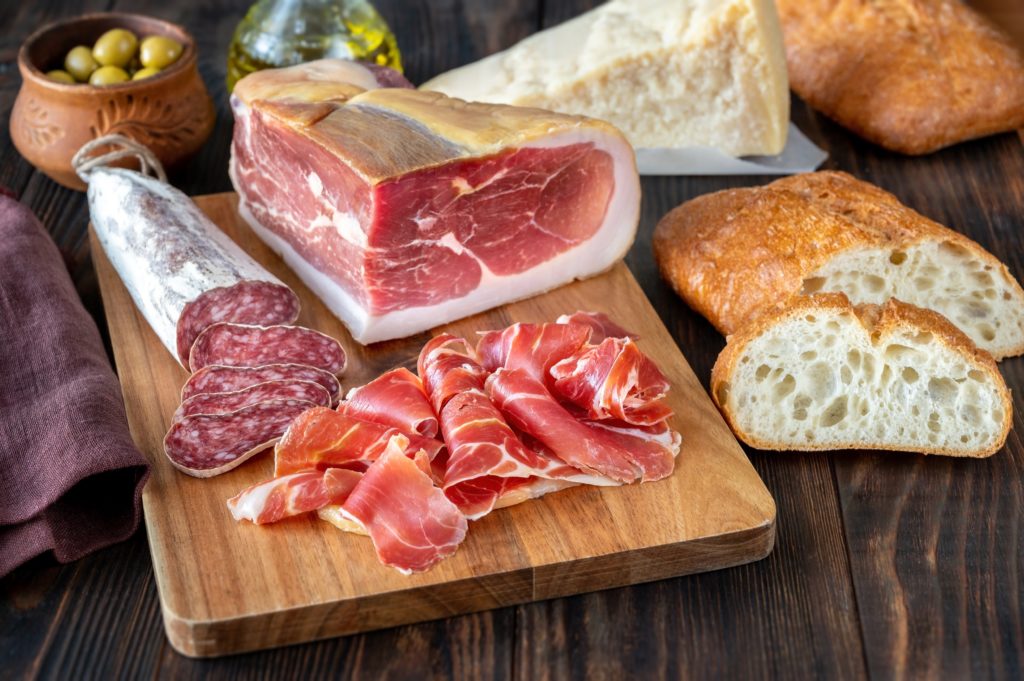
ABSTRACT:
The primary objective of this study was to monitor viability of Shiga toxin–producing Escherichia coli (STEC), Salmonella spp., and Listeria monocytogenes during preparation and storage of fuet. Regarding methodology, coarse-ground pork (ca. 35% fat) was mixed with salt (2.5%), dextrose (0.3%), starter culture (ca. 7.0 log CFU/g), celery powder (0.5%), and ground black pepper (0.3%) and then separately inoculated with a multistrain cocktail (ca. 7.0 log CFU/g) of each pathogen. The batter was stuffed into a ca. 42-mm natural swine casing and fermented at 23 ± 2°C and ca. 95% ± 4% relative humidity to ≤pH 5.3 (≤48 h). Sausages were then dried at 12 ± 2°C and ca. 80% ± 4% relative humidity to a water activity (aw) of 0.89 (within 33 days) or aw 0.86 (within 60 days). A portion of each batch of fuet was subjected to high-pressure processing (HPP; 600 MPa for 3 min) before chubs were vacuum packaged and stored for 30 days at 20 ± 2°C. The results revealed that pathogen numbers remained relatively unchanged after fermentation (≤0.35 log CFU/g reduction), whereas reductions of ca. 0.8 to 3.2 log CFU/g were achieved after drying fuet to aw 0.89 or 0.86. Regardless of whether fuet was or was not pressure treated, additional reductions of ca. 2.2 to ≥5.3 log CFU/g after drying were achieved following 30 days of storage at 20°C. For non–HPP-treated fuet dried to aw 0.89 and stored for 30 days at 20°C, total reductions of ≥5.3 log CFU/g in levels of STEC or Salmonella spp. were achieved, whereas levels of L. monocytogenes were reduced by ca. 3.6 log CFU/g. Total reductions of ≥5.3 log CFU/g in levels of all three pathogens were achieved after drying non–HPP-treated fuet to aw 0.86. For fuet dried to aw 0.89 or 0.86, that were pressure treated and then stored for 30 days at 20°C, total reductions of >6.2 log CFU/g in levels of all three pathogens were achieved. In conclusion, the processing parameters tested herein, with or without application of HPP, validated that reductions of ≥2.0 or ≥5.0 log CFU/g in levels of STEC, Salmonella spp., and L. monocytogenes were achieved during preparation and storage of fuet.
HIGHLIGHTS
- Fermentation alone achieved a ≤0.35-log reduction of the pathogens tested.
- Greater reductions in pathogen levels were achieved by drying fuet to aw 0.86 versus 0.89.
- High-pressure treatment of fuet is an effective postfermentation intervention.
- Recipe and protocol tested delivered reductions of ca. 3.6 to ≥6.7 log CFU/g of the pathogens tested.
- Fuet does not support outgrowth of the pathogens tested during storage.
Citation:
ANNA C. S. PORTO-FETT, ESTEVE ESPUÑA, LAURA E. SHANE, BRADLEY A. SHOYER, LIANNA MCGEARY …
Journal: Journal of Food Protection
J Food Prot (2022) 85 (5): 879–889.



